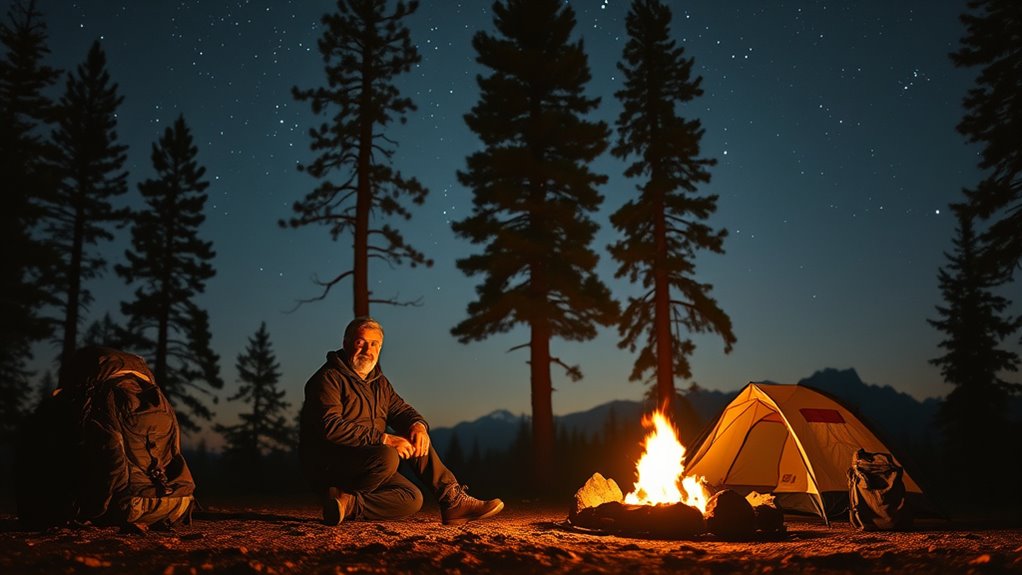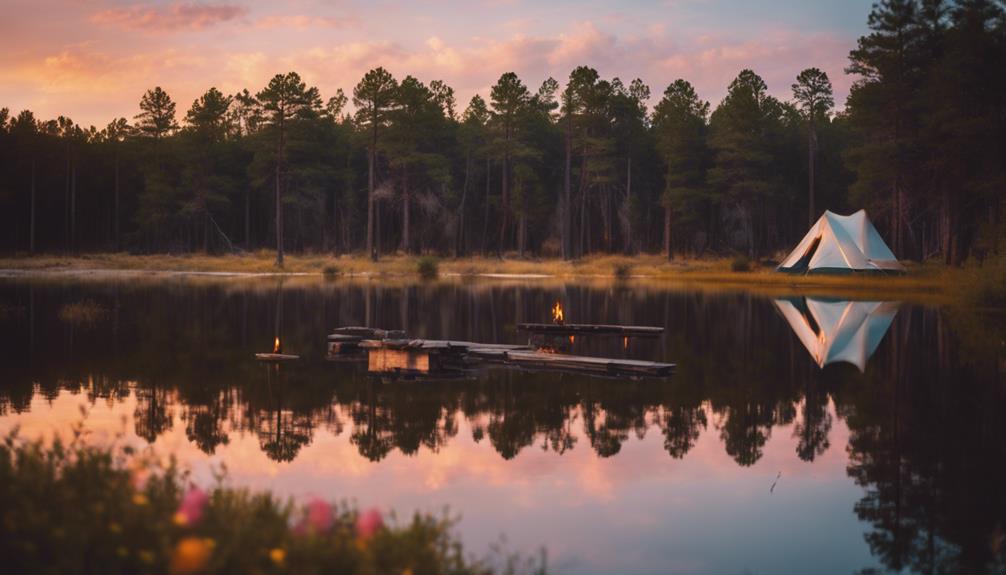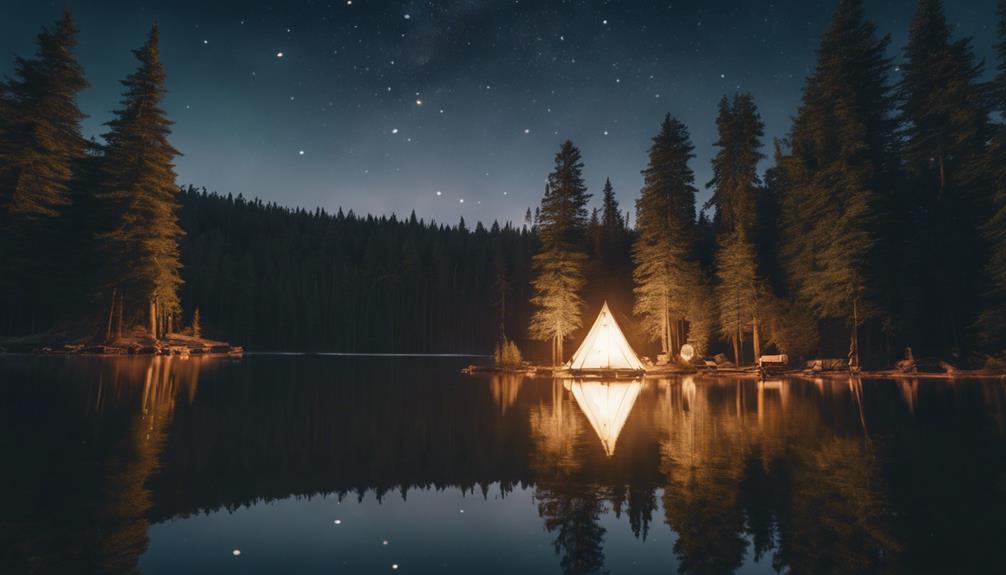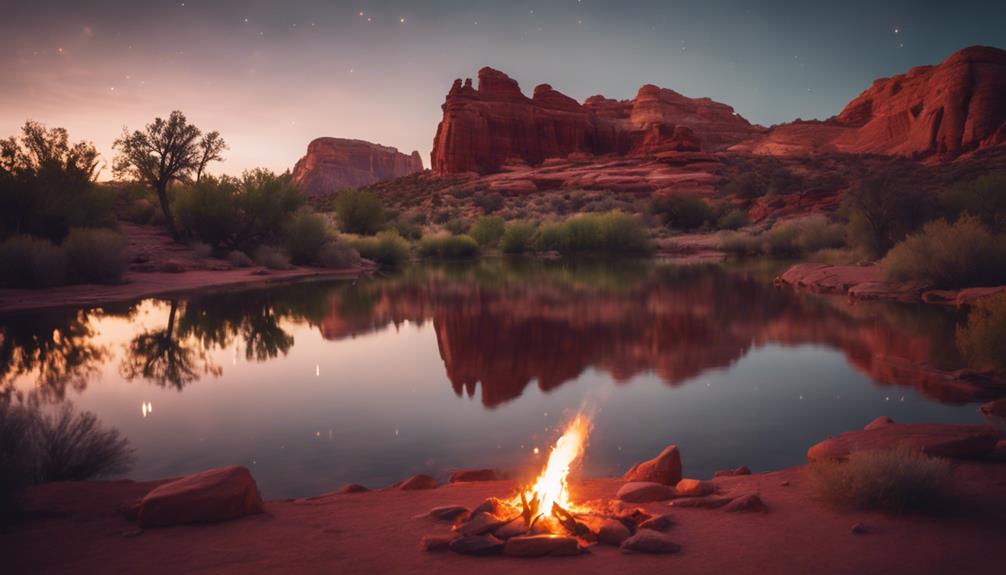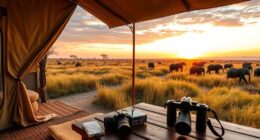Starting on a solo camping adventure demands careful planning and confidence. Research your location’s terrain, weather, and wildlife to stay prepared. Pack essential safety gear like a first aid kit, flashlight, and multi-tool. Choose a flat, stable campsite and inform trusted contacts of your plans. Use navigation tools and stick to daylight hikes for safety. Trust your instincts and adapt as needed. To discover how to enhance your confidence and stay safe, explore some helpful tips ahead.
Key Takeaways
- Research your camping site thoroughly to understand terrain, weather, and wildlife risks.
- Pack essential safety gear like a first aid kit, flashlight, whistle, and multi-tool.
- Inform trusted contacts of your plans, location, and expected return time.
- Use offline maps or GPS for navigation and plan hikes during daylight hours.
- Prepare for emergencies with a portable charger, survival skills, and a personal locator beacon if needed.
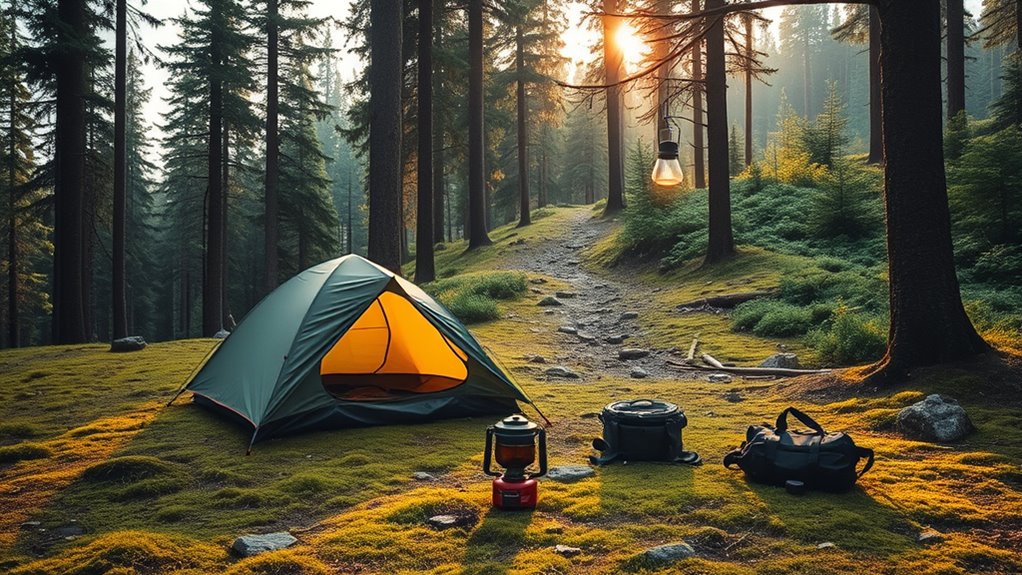
Beginning on a solo camping trip opens the door to a world of adventure, self-discovery, and serenity. It’s a chance to disconnect from everyday routines and immerse yourself in nature’s quiet embrace. But as exhilarating as it is, venturing out alone requires careful preparation, especially when it comes to camping safety and solo adventure planning. You want your experience to be memorable for all the right reasons, which means taking proactive steps to minimize risks and maximize enjoyment.
First, focus on camping safety by thoroughly researching your chosen location. Know the terrain, weather conditions, and local wildlife. Pack essential safety gear—first aid kit, flashlight, multi-tool, and a whistle for emergencies. Make sure your tent is sturdy and suitable for the environment, and always set up your campsite on flat, stable ground away from potential hazards like falling branches or flood-prone areas. It’s vital to inform a trusted friend or family member about your plans, including your expected return time and your exact location. This way, someone can alert authorities if you don’t check in as scheduled.
Solo adventure planning involves more than just packing the right gear; it’s about crafting a detailed itinerary that balances activity with rest. Map out your routes beforehand, preferably with offline maps or GPS devices, so you’re not left stranded if cell service drops. Schedule your hikes or explorations during daylight hours, and always carry extra food and water, even for short trips. Remember, you’re your best safety advocate, so listen to your instincts—if something feels off or unsafe, trust your gut and adjust your plans accordingly.
Preparing for unexpected situations is part of smart solo adventure planning. Keep a small repair kit handy for gear mishaps, and familiarize yourself with basic survival skills such as building a fire or sourcing clean water. Carrying a portable charger or spare batteries for your devices ensures you stay connected or can call for help if needed. Also, consider bringing along a personal locator beacon (PLB) or satellite messenger if you’re heading into remote areas, giving you an extra layer of security. Additionally, understanding the role of contrast ratio in projectors can be useful when choosing the right equipment for your outdoor viewing setup, ensuring clear visibility in various lighting conditions.
Ultimately, your solo camping trip becomes a rewarding experience when you approach it with careful thought and respect for nature’s power. By prioritizing camping safety and planning meticulously, you set yourself up for a confident, enriching adventure that not only tests your resilience but deepens your connection to the wilderness. The freedom of exploring alone is unmatched, but it’s your preparation that turns potential risks into opportunities for growth and discovery.
Frequently Asked Questions
What Should I Do if I Encounter Wildlife at Night?
If you encounter wildlife at night, stay calm and keep your distance to guarantee nighttime safety. Make yourself look bigger by raising your arms or opening your jacket, and speak loudly to alert the animal of your presence. Back away slowly without turning your back, and never run. Carry a whistle or bear spray for added protection. Remember, respecting wildlife helps keep you safe and preserves their natural habitat during your solo adventure.
How Can I Find Reliable Emergency Communication in Remote Areas?
Imagine your connection as a lifeline in a vast wilderness. To find reliable emergency communication, pack a satellite phone, your digital compass in remote areas. Download emergency apps that work offline and alert rescuers with a single tap. Test your devices beforehand, ensuring they’re charged and functional. With these tools, you’ll have a safety net woven into the fabric of your adventure, ready to catch you if things go awry.
What Are the Best Ways to Prevent Loneliness During Solo Trips?
To prevent loneliness during solo trips, join group activities or local meetups to connect with fellow adventurers. Engage in shared hikes, workshops, or campsite events to build bonds and share experiences. These interactions boost your confidence and remind you you’re not alone in the wilderness. Embrace the social side of camping by actively seeking out community moments, turning solitude into a chance for meaningful connections and memorable stories.
How Do I Handle Unexpected Weather Changes Alone?
When unexpected weather hits, stay calm and adapt quickly. Rely on your weather preparedness by checking forecasts often and packing versatile gear like waterproof clothing, a sturdy tent, and thermal layers. Quickly secure your setup, shelter yourself from wind and rain, and stay dry to prevent hypothermia. Trust your gear selection—these essentials keep you safe, confident, and ready to face nature’s surprises head-on.
What Safety Gear Is Essential for Solo Camping?
Imagine you’re a lone wolf traversing the wilderness — your safety gear essentials are your trusted pack. You’ll need a reliable first aid kit, sturdy camping equipment like a tent and sleeping bag, a multi-tool, and a headlamp. Don’t forget a whistle and waterproof clothing for surprises. These essentials keep you prepared, confident, and safe, turning your solo adventure into a story of resilience and discovery.
Conclusion
Venturing into solo camping is like exploring a vast, uncharted wilderness—you’ll face surprises, but each step boosts your confidence. I remember my first night alone, feeling vulnerable yet empowered, just like a lone wolf howling under the stars. With preparation and awareness, you’ll discover that the greatest adventure lies in trusting yourself amidst nature’s embrace. Embrace the journey, stay safe, and let your courage turn every campsite into a personal sanctuary of discovery.

